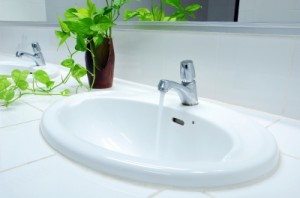Water Conservation
The annoying drip, drip, drip of a leaky faucet can be costly for you and the environment.
The annoying drip, drip, drip of a leaky faucet can be costly for you and the environment.
Leaky faucets waste thousands of gallons of water per household each year, a costly mistake for your wallet and the environment. Similar to our article on toilet leaks, we will help you uncover the facts about how much water is actually wasted and how to keep that hard earned cash in the bank. While we focus on the average household, these tips can also apply to small business owners and retailers looking to cut costs and go green.
 As you lie in bed and hear the annoying drip, drip, drip of a leaky faucet, you are literally listening to money going down the drain. We should also not forget that only 1% of the water on the earth’s surface is usable to human consumption, therefore water conservation is critical to your survival. So how bad can a leaky faucet really be? Well, a slow drip can waste about 7-10 gallons of water per day, adding up to more than 3,600 gallons of water per year. This simple small leak can cost you about $20 per year. A more significant faucet leak can produce 30 to hundreds of gallons of wastewater per day. The average costs of these fast dripping faucets will end up costing you $60 to $200 per year. If every American household had a leaky faucet dripping at just one drop per second, we would waste 928,000,000 gallons of water per day.
As you lie in bed and hear the annoying drip, drip, drip of a leaky faucet, you are literally listening to money going down the drain. We should also not forget that only 1% of the water on the earth’s surface is usable to human consumption, therefore water conservation is critical to your survival. So how bad can a leaky faucet really be? Well, a slow drip can waste about 7-10 gallons of water per day, adding up to more than 3,600 gallons of water per year. This simple small leak can cost you about $20 per year. A more significant faucet leak can produce 30 to hundreds of gallons of wastewater per day. The average costs of these fast dripping faucets will end up costing you $60 to $200 per year. If every American household had a leaky faucet dripping at just one drop per second, we would waste 928,000,000 gallons of water per day.
It’s a good practice to check for leaking faucets both in the kitchen and bathroom around your home or office on a regular basis. A leaky faucet can normally be seen visually and if you detect one, fix it immediately. However, sometimes some dripping faucets can be overlooked. While looking for a puddle of water around a faucet that has been turned off is the simple way to identify leaks, there are some other tactics to try. Wrapping a towel around the faucet or hanging a plastic bag under the faucet and check to see if any water collects throughout the day. I accidentally detected a small leaky faucet in my shower when I hung my shower cap on the faucet and noticed that it collected water in the evening.
The good news is that repairing a leaky faucet is not a difficult task. Once you detect a leaky faucet, repairing it yourself can save hundreds on a plumber. Worn rubber washers are usually the cause of leaky faucets. In most cases, to repair a leaky faucet, you just need to replace the worn washer, o-rings or valves. You can purchase the faucet repair parts or faucet repair kits at any home improvement stores or online at stores like Amazon.com. A faucet repair kit is the best way to go because it contains instruction on how to repair the faucet and also comes with tools that you may need. The washer on a faucet is usually located under the handle. You will need to shut off the water under the sink or at the water shutoff valve, remove the handle and follow the instructions to restore the faucet.
Fixing a leaky faucet is a simple and inexpensive action that you can take to save money and conserve water. With 85% of our water coming from ground water pumped from aquifers, reducing water consumption will also save money on pumping equipments, and in turn will lower the cost of providing water, potentially further reducing your water bill.
Image: twobee